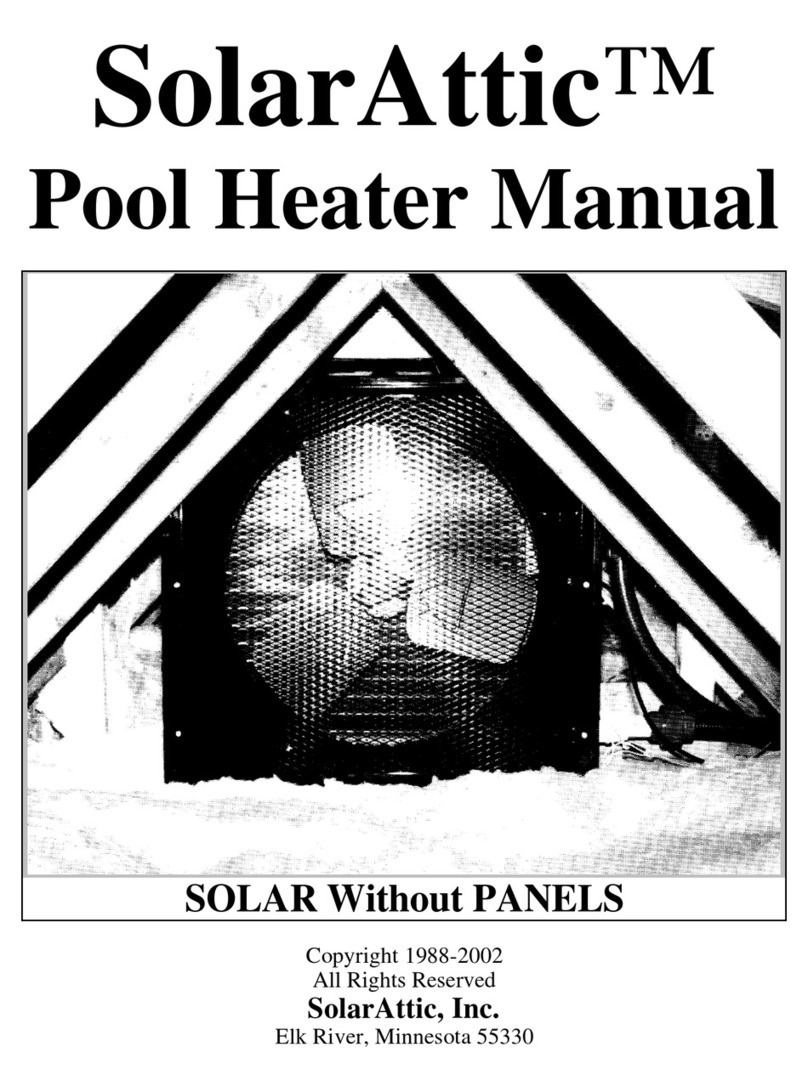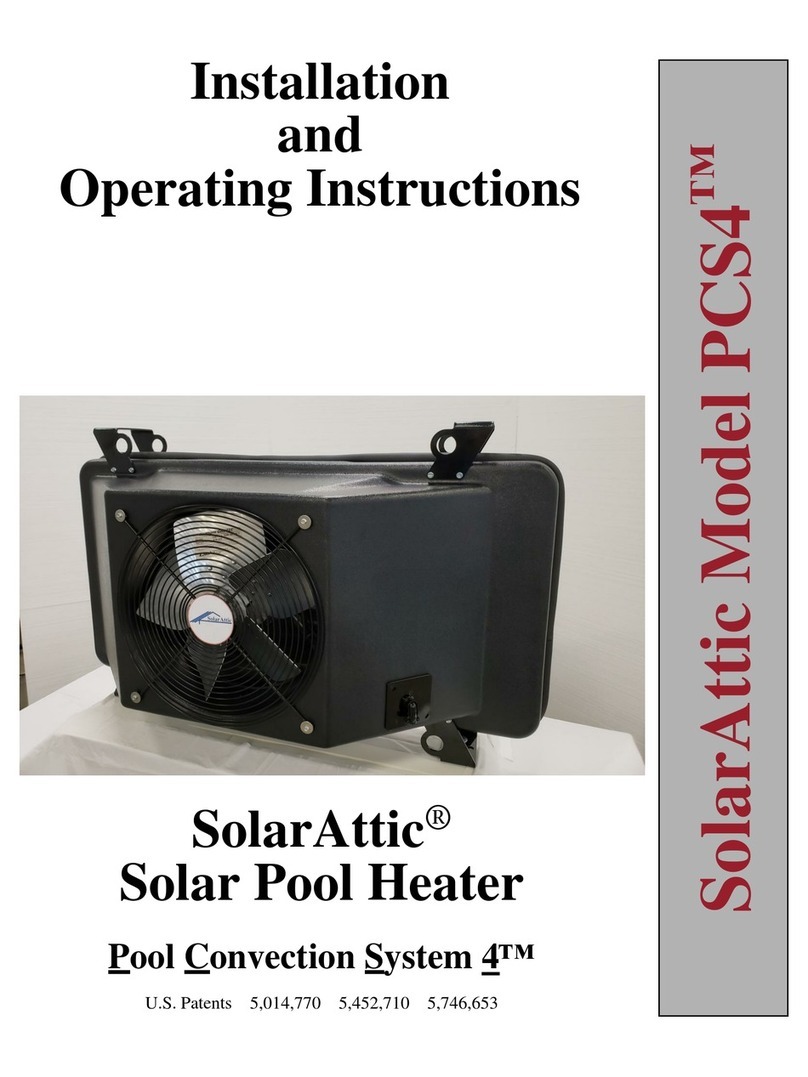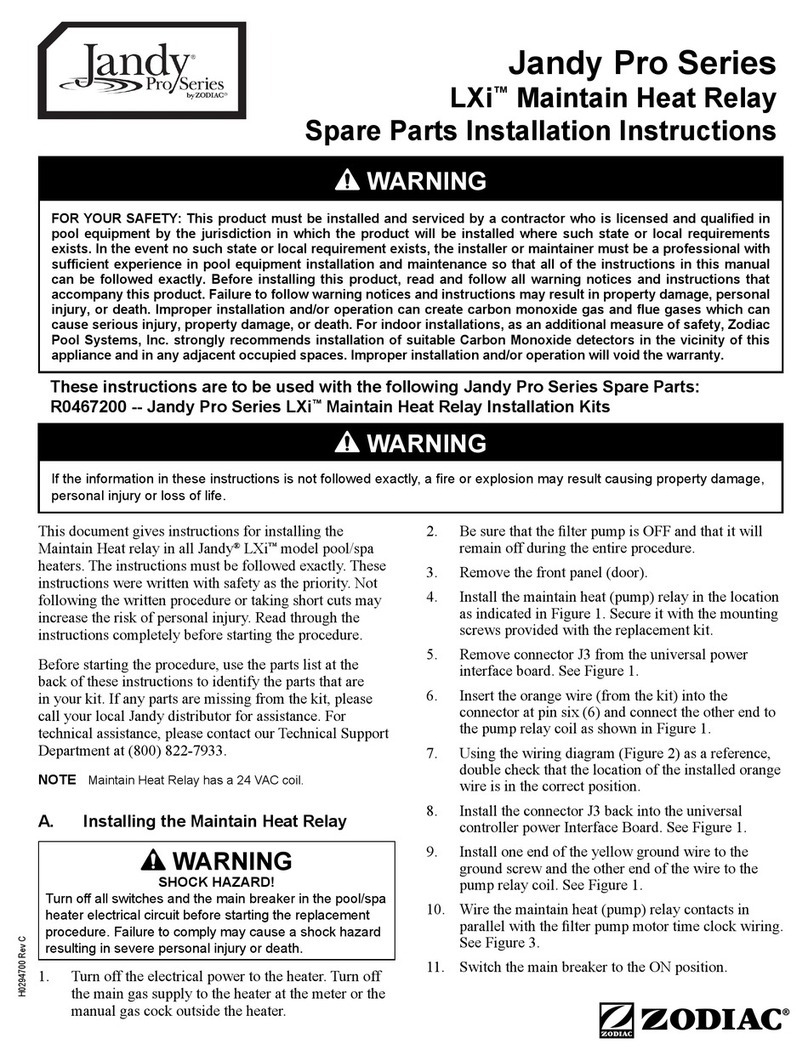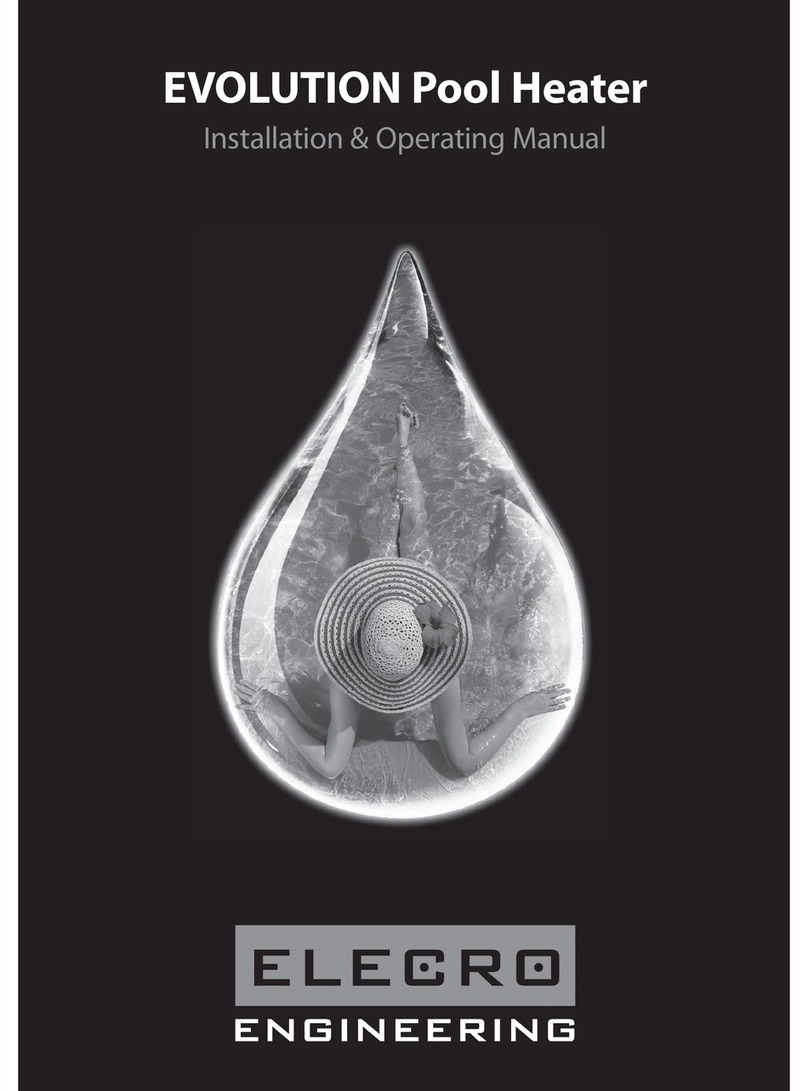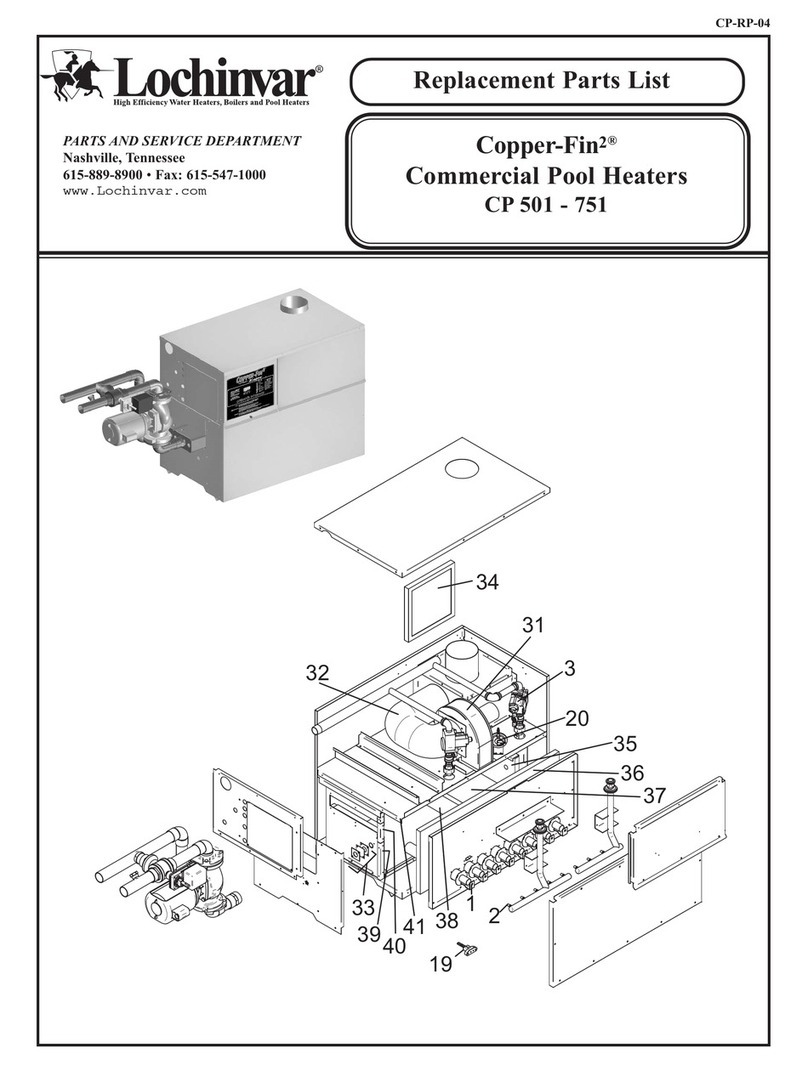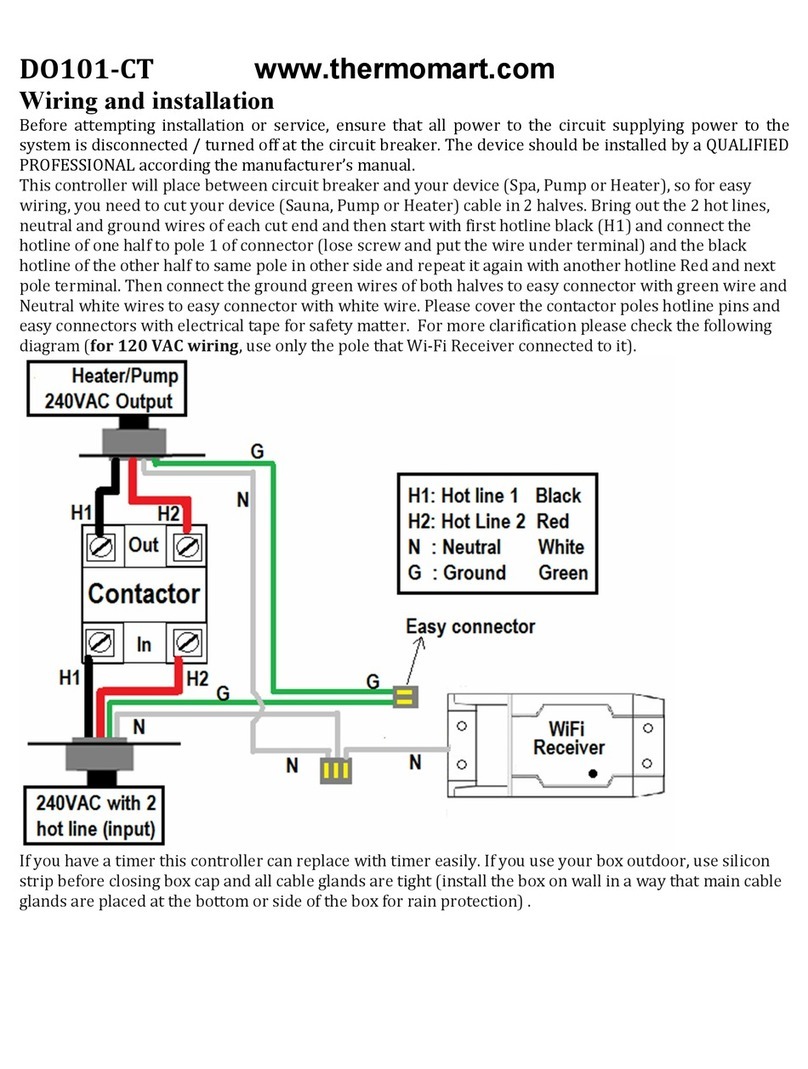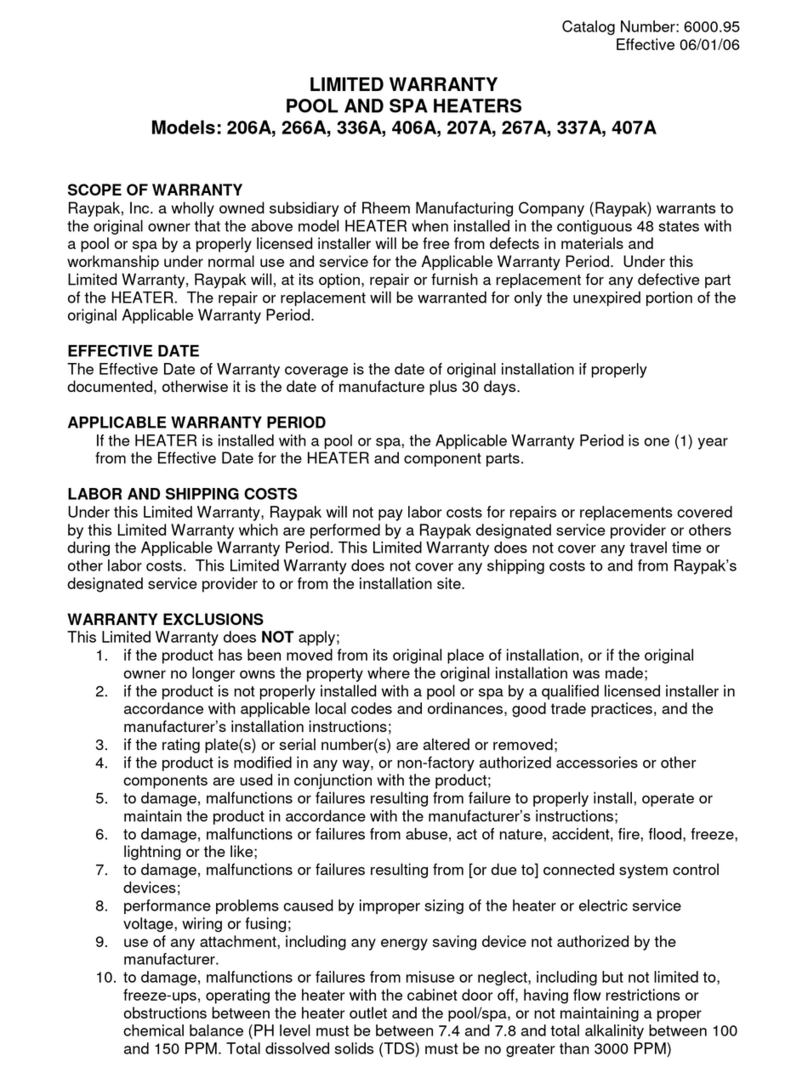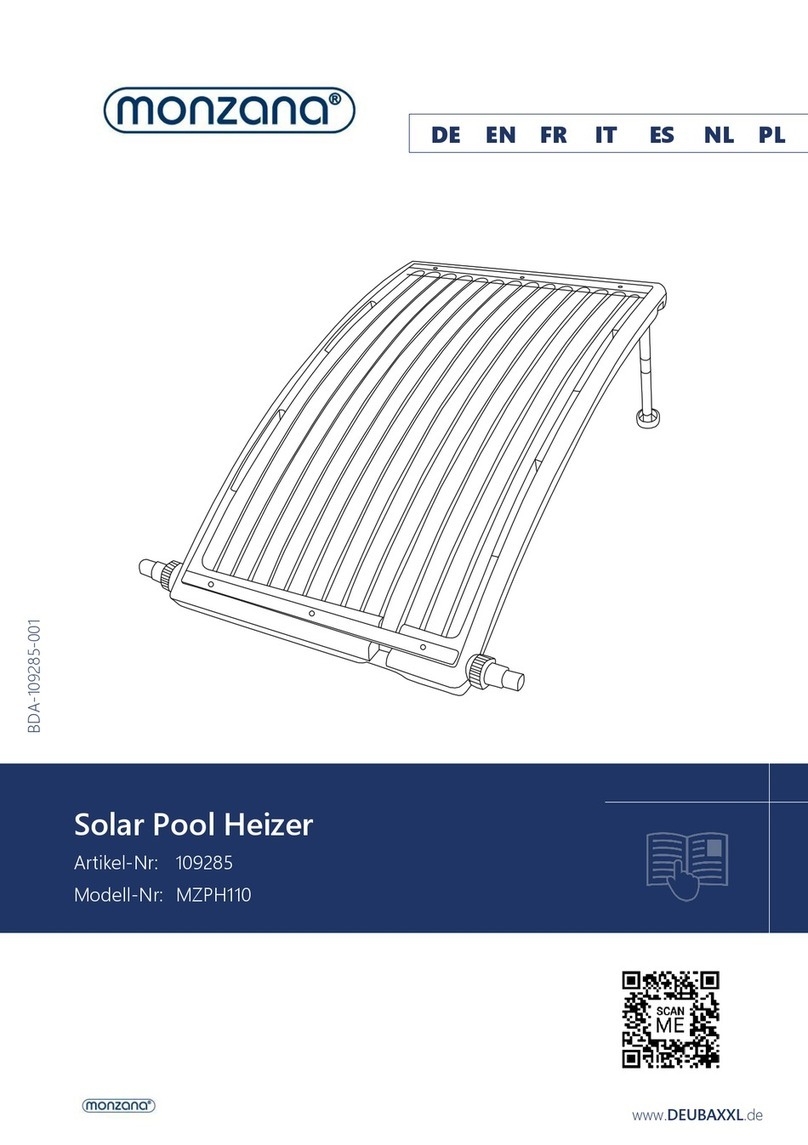SolarAttic PCS3 User manual

Installation
and
Operating Instructions
SolarAttic®
Solar Pool Heater
Pool Convection System Three™
U.S. Patents 5,014,770 5,452,710 5,746,653
SolarAttic Model PCS3™

This page intentionally left blank.

Table of Contents
Table of Contents .....................................................................................................................1
1. Introduction to SolarAttic ................................................................................................2
• Solar Without Panels ...................................................................................................2
• Basic Operation ...........................................................................................................2
• Description of Technology ..........................................................................................2
• Automation .................................................................................................................2
2. Consider Before Installation .........................................................................................2-3
3. Cautions & Warnings ....................................................................................................4-6
4. Installation ....................................................................................................................6-15
• ABC’s of Installation ..................................................................................................6
• Locate the SolarAttic PCS3 ........................................................................................6
• Retrofit Support System ..........................................................................................6-7
• Basic Plumbing Diagram ............................................................................................8
• Power The PCS3 .........................................................................................................9
• Internal Wiring Diagram ...........................................................................................10
• Float Wiring Diagram ...............................................................................................11
• Goldline GL235 Solar Control .................................................................................12
• Goldline GL235 Circuit Board .................................................................................13
• Automation Wiring Diagram ...................................................................................14
• Goldline GL235 Wiring Option ................................................................................15
5. Operation .........................................................................................................................16
6. General Service Notes .....................................................................................................17
7. Spring Start Up ................................................................................................................17
8. Winterization ..............................................................................................................18-19
9. Winter Freeze Warnings .................................................................................................19
10. Unattended Pools ........................................................................................................19-20
11. Repairs ..............................................................................................................................20
12. System Troubleshooting ..................................................................................................20
•Troubleshooting Guide .........................................................................................21-25
13. Safety Certification Label ...............................................................................................26
14. Specifications ...................................................................................................................27
15. Warranty ..........................................................................................................................28
- 1 -

1. Introduction to SolarAttic
SOLAR Without PANELS: SolarAttic has
engineered the Pool Convection System 3 to
heat your swimming pool using your
attic and roof as a source of free energy.
When your attic gets hot, the SolarAttic
Swimming Pool Heater can add six
weeks on to each end of your swim-
ming season and can raise your pool
temperature 10-15 degrees over a
non-heated state. That means
your family can enjoy the
swimming pool without
having to pay high heat-
ing bills. You get the
benefits of solar pool
heating without
roof mounted so-
lar panels.
BASIC
OPERATION:
The simplified
graphic diagram
to the right shows
how the PCS3
works. When the
sun shines, the roof
acts as a large solar collec-
tor. Heat accumulates inside the attic. The PCS3 safely uses this attic heat to warm your pool. It elimi-
nates the need for solar roof panels. AND, as it heats your pool, it cools your home! This house cooling
effect can lower air conditioning costs 25-30% or more.
DESCRIPTION OF TECHNOLOGY: Solar radiation strikes the roof and reaches the attic through a
process called “conduction.” The SolarAttic pool heater is physically located inside the attic and then
transfers this solar radiation from the attic air into the swimming pool’s water through a process called
“forced air convection.”
AUTOMATION:Full Automation is achieved by using an optional solar controller. When the attic is
4°F warmer than the pool and the pool needs heat, the GL235 solar control automatically routes water
up to the PCS3 and turns it on. The solar control can also synchronize the pool pump turning it on at the
same time when an external relay is used in conjunction with the GL235. Temperature sensors sense the
pool and attic temperatures. The pool owner sets the desired pool temperature setting and maximum
heat extraction in the attic occurs automatically. Note: The pool pump must be turned on during the
time the PCS3 is turned on to effect heat transfer. And, water and air flow must be in sync.
2. Consider Before Installation
The following items should be considered prior to any installation.
1. Heat rises in a hot attic. Locate the PCS3 as high in the attic as is practical.
- 2 -
Cools your home,
as it heats the pool!

2. Airflow through the PCS3 is important. Do not obstruct air going in or out of the unit.
3. Recirculating the air within the attic works well for heat transfer. Locate the PCS3 within
the middle 1/3 of the attic. Do not locate near an end wall where the unit’s airflow will
become obstructed [finned intake side] or short circuited [air discharge side]. Short cir-
cuiting means that discharged cooler air reflects back into the finned intake side of unit.
4. Heat is drawn into the coil or finned side and cooler air is discharged from the fan side
[the two blower openings]. If the PCS3 is located off to one side the attic’s center 1/3rd,
make sure the coil side of the unit is facing the longest portion of the attic.
5. You can suspend the PCS3 on a platform using cargo straps or small chains. You can also
allow the PCS3 to sit on a platform that is connected to the attic structure. We recom-
mend that a one inch piece of foam be placed under the PCS3 and that a smitty pan be
used as a second layer of leak protection. This is actual plumbing code in some locales.
6. The attic sensor can be cooled by the air discharge of the PCS3. Locate the attic sensor at
the peak of the attic and out of the airflow of the unit. This prevents erratic on and off
cycling caused by the cooling effect of the discharge air. Note: The discharge air of the
PCS3 [blower side of unit] can run 20-30 degrees fahrenheit cooler than the intake air
[coil finned side of unit]. All performance criteria was developed on the basis that the at-
tic temperature sensor would sense the PEAK attic temperature. That is the temperature
at the very apex of the attic where the roof sections join. If this sensor is lowered from
the actual attic peak, heat transfer performance can be dramatically reduced.
7. The pool water sensor can be influenced by the sun and rain. Shelter the pool water
sensor as much as is possible. It can even be insulated if necessary with fiberglass or
other materials. Midnight rain “cooling” the pool sensor can fake the solar control into
thinking the pool needs heat when it doesn’t. An exposed pool sensor might also cause
erratic on and off conditions if not protected (sheltered or insulated) properly.
8. The ground can “SINK” heat away from pipes going to and from the PCS3. Insulate or
wrap all underground pipes so dirt (the ground) does not contact the pipes directly.
Simple bubble wrap over the pipes that prevent the “wet ground” from coming into direct
contact with the horizontal buried pipes is usually sufficient. It is not necessary to
insulate vertical above ground pipes.
9. Use 2" pvc pipe to reduce friction losses and on all pools with a pool pump greater than
one horsepower in size. This is especially important for long pipe runs and large pumps.
10. If you use the recirculating freeze protection in the GL235, it will disable the optional
leak detection float of the PCS3 and prevent the pump and/or the PCS3 from turning off.
11. The mechanical stress caused by unsupported pipes can crack glued pvc joints. Support
all pipes in and outside of the attic with straps or C-clamps that keep the weight of the
pipes off of all joints and union connections. Do not allow the pipe to sag in the attic.
12. If excessive attic heat is a local concern, CPVC pipe can be used instead of pvc pipe. All
external PVC piping should be painted to avoid deteriation from sunlight. Flex pvc pipe
can be used in the attic to avoid cementing joints in a closed and confined area. This will
provide a continuous length of pipe inside the attic without joints except at the unit.
- 3 -

3. Cautions & Warnings
The following notes are CAUTIONS & WARNINGS designed to inform you of the existence of
areas of potential injury and hazard. These notes help to prevent personal injury and fatalities.
They will also help prevent damage to the SolarAttic Swimming Pool heater, swimming pool
systems or to the house.
MAKE SURE YOU READ AND UNDERSTAND THESE CAUTIONS & WARNINGS!
- 4 -
CHILDREN CAUTION: SHARP EDGES ON THE SOLARATTIC POOL HEATER CAN CAUSE CUTS
OR INJURIES. THIS IS NOT A PRODUCT THAT CHILDREN SHOULD BE ALLOWED TO TOUCH.
THEIR NATURAL CURIOSITY CAN RESULT IN INJURY OR ACCIDENT. **KEEP ALL CHILDREN
AWAY FROM THIS PRODUCT TO PREVENT CUTS, INJURIES OR ACCIDENTS**
ELECTRICAL DANGER: THIS PRODUCT USES 115 VAC POWER AND CAN CAUSE A FATAL
INJURY IF SERVICED BY INEXPERIENCE PEOPLE. THIS MANUAL ASSUMES THAT AN
EXPERIENCED ELECTRICIAN IS BEING EMPLOYED. ALL ELECTRICAL WIRING MUST BE
DONE IN ACCORDANCE WITH LOCAL, STATE AND NATIONAL ELECTRICAL CODES.
PLUMBING CAUTION: THIS PRODUCT REQUIRES PVC CEMENT WELDING AND THIS
MANUAL ASSUMES AN EXPERIENCED PLUMBER IS BEING EMPLOYED. DO NOT ACCEPT
ANY LEAKING PVC JOINTS. DO NOT “LEARN” PVC CEMENT WELDING ON THE EXPENSIVE
POOL VALVES PURCHASED. DAMAGE TO THE VALVES FROM POOR PVC WELDING IS NOT
COVERED BY THE MANUFACTURERS WARRANTY. ASSEMBLE THE VALVES AND PIPES
BEFORE ACTUAL WELDING TO MAKE SURE THE JOINTS FIT PROPERLY. THIS INSURES
YOUR PARTS ARE READY FOR PERMANENT CEMENTING.
PLUMBING CAUTION: DO NOT USE DRAIN-WASTE (HOUSE SINK OR DRAIN) PVC FITTINGS
(45°OR 90°ELBOWS, STRAIGHT SXS FITTINGS, ETC.) ON YOUR POOL’S SUPPORT SYSTEM
RE-ASSEMBLY. USE SCHEDULE 40 PVC OR CPVC FITTINGS. THE DRAIN-WASTE PVC
FITTINGS DO NOT HAVE THE SAME DEPTH OF PVC PIPE PENETRATION, WHICH COULD
RESULT IN THE POOL’S PVC PIPE POPPING AWAY FROM THE SHORTER DRAIN-WASTE PVC
FITTING (ELBOW, ETC.).
FIN CAUTION: THE FINS ON THE WATER COIL ARE SHARP AND CAN CAUSE A RAZOR- LIKE
CUT IF YOUR HAND OR ARM COME INTO CONTACT WITH THEM. TAKE APPROPRIATE CARE
DURING INSTALLATION AND DO NOT COME INTO DIRECT CONTACT WITH THE FINS OF THE
COIL. IF THE COIL FINS ARE ACCIDENTALLY DAMAGED, THEY CAN BE “COMBED” STRAIGHT
WITH A FIN COMB [10 FINS PER INCH].
AIR MOVING ASSEMBLY CAUTION: THE PROTECTIVE GRILLE AND OTHER PARTS OF THE
AIR MOVING ASSEMBLY, INCLUDING THE BLOWER BLADES AND MOTOR HAVE SHARP
EDGES WHICH CAN CUT YOUR FINGER OR HANDS. EXERCISE CAUTION WHEN HANDLING,
REMOVING OR INSTALLING ANY PART OF THE AIR MOVING ASSEMBLY.
BLOWER CAUTION: DO NOT OPERATE THE MOTOR WITH THE AIR MOVING ASSEMBLY
REMOVED. THE PROTECTIVE GRILLE IS TO PREVENT HARM WHILE THE BLOWER UNIT IS
OPERATING. UNPLUG THE SOLARATTIC POOL HEATER DURING SERVICE AND ENSURE
THAT THE BLOWER HAS STOPPED ROTATING.

MOTOR CAUTION: DO NOT OPERATE THE MOTOR FOR AN EXTENDED TIME WITHOUT THE
SQUIRREL CAGE ASSEMBLY ATTACHED. THE MOTOR IS A “TOTALLY ENCLOSED AIR OVER”
MOTOR [TEAO] AND THE AIRFLOW OVER THE MOTOR FROM THE CAGE PROVIDES MOTOR
COOLING. OPERATING THE MOTOR WITHOUT THE CAGE ASSEMBLY ATTACHED WILL LEAD
TO THE MOTOR OVER HEATING AND A THERMAL CUTOFF OF THE MOTOR [INTERNALLY].
TEKS SCREW CAUTION: DO NOT REPLACE ANY SELF-TAPPING #10-1/2 TEKS SCREW USED
ON THE REAR COIL SIDE WITH ANY SHEET METAL SCREW GREATER THAN ONE-HALF INCH
(1/2”) IN LENGTH. DOING SO CAN DAMAGE THE WATER COIL BY PUNCTURING ONE OF THE
COIL’S WATER PIPES OR MANIFOLDS. AS A GENERAL RULE, DO NOT USE ANY SHEET
METAL SCREW GREATER THAN 1/2 INCH IN LENGTH ON THE SOLARATTIC POOL HEATER.
WEIGHT CAUTION: THE PCS3 WEIGHS ABOUT 221 LBS CRATED AND 142 LBS UNCRATED.
IN ADDITION, THE UNIT IS BULKY. CAUTION SHOULD BE TAKEN WHEN LIFTING THE UNIT
SO AS NOT TO TWIST FROM THE WAIST OR TO PLACE A BURDEN ON THE LOW BACK. NO
ATTEMPT SHOULD BE MADE TO LIFT THE UNIT ALONE. TWO OR MORE MEN SHOULD BE
PRESENT. ATTEMPTING TO LIFT OR HANDLE THE PCS3 ALONE CAN LEAD TO PHYSICAL
INJURY. NOTE: THE PCS3 FILLED WITH WATER WEIGHS ONLY 163 LBS.
POOL CHEMISTRY CAUTION: AN IMPROPERLY MAINTAINED POOL WILL TURN ACIDIC VERY
FAST AND DAMAGE ALL OF THE POOL’S SUPPORT EQUIPMENT INCLUDING THIS HEATER.
MAINTENANCE OF POOL WATER CHEMISTRY IS A SERIOUS RESPONSIBILITY OF OWNING A
SWIMMING POOL. LOCATE ALL CHEMICAL DISPENSERS DOWNSTREAM FROM THE PCS3.
NOTE: IF YOUR POOL WATER IS CRYSTAL CLEAR, DRINKABLE AND DOES NOT SMELL OF
CHLORINE -- YOU HAVE THE RIGHT POOL CHEMISTRY. CHECK WITH YOUR LOCAL POOL
CHEMICAL DEALER IF YOUR POOL DOES NOT HAVE THESE ATTRIBUTES!
BUILDING CODE CAUTION: INSTALL ALL EQUIPMENT IN ACCORDANCE WITH LOCAL, STATE
AND NATIONAL BUILDING CODES TO PREVENT ANY INJURY, FATALITIES OR DAMAGE TO
EQUIPMENT.
INSTALLATION DANGER: USE ADEQUATE VENTILATION WITHIN THE ATTIC IF YOU PLAN TO
CEMENT PVC JOINTS. PVC CEMENT FUMES CAN BE TOXIC IN THE ATTIC AND CAN LEAD TO
HEALTH PROBLEMS OR INJURY. COMPLETE ALL ATTIC INSTALLATION TASKS IN THE
MORNING WHEN HEAT BUILD UP IS MINIMAL TO PREVENT HEAT STROKE OR OTHER
INJURY. NOTE: A CONTINUOUS LENGTH OF FLEX PVC PIPE CAN BE USED IN THE ATTIC TO
MINIMIZE PVC CEMENTING IN THE CLOSED ATTIC ENVIRONMENT.
INSTALLATION CAUTION: SOME LOCAL BUILDING CODES REQUIRE THAT A SMITTY PAN BE
INSTALLED UNDER ANY ATTIC EQUIPMENT FOR ADDITIONAL PROTECTION FROM ATTIC
EQUIPMENT FAILURE. NOTE: A SMITTY PAN IS AN EXTRA WATER COLLECTION TRAY
PLACED UNDER ATTIC EQUIPMENT THAT IS TAPPED AND CONNECTED TO A HOSE TO
DRAIN EXCESS FLUIDS OUTSIDE.
NOTE: SMITTY PANS CAN USUALLY BE PICKED UP AT LOCAL PLUMBING SUPPLIERS. THEY
CAN ALSO BE BUILT BY ANY SHEET METAL FABRICATOR. A SMITTY PAN INSTALLATION IS
RECOMMENDED AS AN ADDED LAYER OF PROTECTION FOR ANY INSTALLATION WHERE
THERE IS A HIGH DEGREE OF CONCERN FOR MAXIMUM PROTECTION AGAINST POTENTIAL
FAILURE OF ATTIC EQUIPMENT. SMITTY PANS ARE A GOOD CONSTRUCTION PRACTICE.
SERVICE DANGER: UNPLUG THE SOLARATTIC POOL HEATER BEFORE ATTEMPTING ANY
SERVICE! FAILURE TO UNPLUG THE UNIT PRIOR TO ANY SERVICE CAN LEAD TO SERIOUS
INJURY OR DEATH. SERVICE SHOULD NOT BE ATTEMPTED BY AN INEXPERIENCED
TECHNICIAN WITHOUT FIRST READING THIS ENTIRE MANUAL!
- 5 -

SERVICE CAUTION: DO NOT CREATE A SITUATION THAT WOULD ALLOW POOL WATER TO
BE INADVERTENTLY ROUTED TO DISCONNECTED ATTIC PIPES. IF THE SOLARATTIC POOL
HEATER IS DISCONNECTED FROM THE ATTIC PIPES, DISCONNECT THE PUMP AND
REMOVE THE VALVE CONTROLS AND HANDLES DURING SERVICE. OR RECONNECT A
BYPASS PIPE IN PLACE OF THE SOLARATTIC POOL HEATER DURING ITS REMOVAL.
FAILURE TO OBSERVE THIS CAUTION CAN LEAD TO SUBSTANTIAL WATER DAMAGE.
- 6 -
4. Installation
Installation of the SolarAttic Pool Heater involves three basic steps:
A) Locate the SolarAttic Pool Heater in the attic.
B) Connect the SolarAttic Pool Heater to the pool’s support system.
C) Connect the SolarAttic Pool Heater to power or Automation equipment.
LOCATE THE POOL HEATER IN THE ATTIC
The PCS3 is the third generation SolarAttic Pool Heater. It has been reduced in size and depth to make
installation in the attic easy. While physically reducing the size, SolarAttic has maintained the 60,000
Btu/hour nominal rating of the original PCS1 pool heater. The PCS3 is expected to fit directly through
95% of all existing attic access panels. The PCS3 basic box dimensions are only 22H x 14W/D x 46L
inches and the unit can be easily and completely disassembled by removing the sheet metal screws if
needed. Therefore, it can be completely disassembled for extremely small access openings and then
reassembled within the attic with nothing more than a battery operated drill and a 5/16 hex driver bit.
Before physically locating the SolarAttic Pool Heater inside the attic, it is a good idea to take the right
service panel off and install mating female pvc union fittings to the 2 inch male pipe threads. When
mating pvc female fittings to the copper pipe threads, we recommend using silicone sealant and allowing
the joints to properly cure for 24 hours before placing them into use. Do not use teflon tape!
Locate the pool heater inside the attic. The shipping crate base may be used as a mounting platform if
not too damaged during shipping and simple cargo straps or small hardware chain can be used to sus-
pend the unit from the apex of the attic. The PCS3 can also sit on a platform secured to the attic trusse
structure as the unit is vibration and noise free. If noise occurs in the wood structure, ensure that a 1"
piece of foam is under the PCS3 and the unit itself is not physically connected to the trusse. Some unit
flexibility is needed for normal winterization of the system in areas where the pool is winterized. Once
the PCS3 is fully installed, there should be little or no noise or vibration heard from within the house.
Remember to place the unit in the center 1/3rd of the attic and locate it as high as possible and practical
inside the attic. This completes the first step. The pool heater now has to be plumbed and powered.
RETROFIT SUPPORT SYSTEM
Connect the SolarAttic Pool Heater to the pool’s plumbing. The existing pool pump is sufficient to
move water to and from the pool in 99% of all installations. Retrofitting the support system is the most
difficult part of plumbing the PCS3. The reason for this is the generally rigid and permanent nature of
the typical PVC type support system plumbing. This usually means having to carve up the PVC pipe
and not being able to salvage and reuse the fittings and in some cases the existing valves also. The good
part about PVC type support systems is that PVC pipe, fittings and general purpose valves are relatively
inexpensive and can be purchased in many hardware, plumbing and home building stores.

If you have a PVC support system that needs to be retrofitted, plan on redoing the entire plumbing lay-
out. This should be done on paper first, before you actually start cutting PVC pipe in the support system.
CAUTION: If you are in an area that freezes, it is common to find a gate valve on all lines
going to the swimming pool. These are the pool’s main drain line, the pool’s return line and
the pool’s skimmer line. In some instances, there may be more than just these three lines
[such as two skimmer lines, etc.]. Do not remove these valves! They are needed to winterize
your swimming pool. In some cases, they may have to be removed and later reinstalled.
Plan on connecting the new valves and PCS3 to the valves and pipes leading to the swimming pool.
When it comes to the filter and pump, simply rearrange these as is needed, as you reconstruct the pool’s
support system’s plumbing.
In the case where copper pipes and brass valves have been used, they can be reused. If copper or brass
has been used, you will need to mate these to pvc pipe which is generally done using a metal to rubber
“mission” coupling that adapts directly to the outside dimensions of both pipes involved. Example:
1 1/2 inch copper pipe has a different O.D. [outside diameter] than 1 1/2-inch PVC pipe. The
appropriate union to couple these pipes will have a rubber insert that matches the different size pipes.
The bypass valve supplied is 2" PVC and can be reduced down to 1 1/2” by using a “reducing bushing”.
Some PVC valves accept both 1 1/2" and 2" PVC fittings directly. Some accept 2 1/2" pipes. NOTE: Be
sure to read the valve manufacturers instructions. Also, it may be easier to use sections of rigid 2” PVC
pipe for installing the valve shipped with the PCS3. This would include using some 2” PVC fittings.
The PCS3 inlet and outlet lines go to the attic. Having the support system located in a convenient spot
for easy attic access is a good strategy. Support systems located far away from the attic can be relocated
closer by extending the pool’s support piping. Extremely long pipe runs may require added horsepower
from the pool’s pump. If your pump is inadequate for the added lift to the attic, it will reduce the flow
of water and result is poorer filtration and it may thermally cut itself off from over heating.
As a general rule, a 1 HP pump can handle a 250 feet round trip and up 25-30 feet in terms of vertical
lift. Each pump has a specific pressure and flow curve that can be referenced if needed to ensure your
pump is adequate. However, with 25 years of experience, I do not know of a single system that HAD to
have a pump upgraded for the SolarAttic solar pool heater. For max heat transfer, use the top opening
as the inlet and the bottom as the outlet. If plumbed opposite, it will not dramatically affect performance.
NOTE: Do not upgrade your pump simply because it feels hot! Your pump will feel “too hot” to touch
by hand under normal operating conditions. If you are building a new pool and installing the PCS3 at
the same time, there is no expense associated with retrofitting the support system.
NOTE: Additional specialty plumbing and wiring diagrams are available at www.solarattic.com and
inside the PCS1 Technical Manual, which can be freely downloaded as needed. The PCS1 Manual has
indepth information concerning solar theory and heat transfer performance curves. Everything in the
PCS1 Manual applies to the PCS3 with the exception of the electrical wiring. The PCS1 is a 220-240
vac system and it requires different wiring considerations. However, the PCS3 is a 110-120 vac system
and plugs into a standard household electrical outlet usually switched by the GL235 solar control. The
nomenclature 110 vac, 115 vac and 120 vac all refer to the same standard household power and are used
interchangeably in various support documents.
The diagram on the next page is the basic plumbing diagram for the SolarAttic Pool Heater. Additional
plumbing diagrams and plumbing options may be found at www.solarattic.com/plumb.htm.
PLUMB THE POOL HEATER AS DESIRED.
- 7 -

SS
SSKK
KKIIIIMM
MMMM
MMEE
EERR
RR
SS
SSUU
UUCC
CCTT
TTIIIIOO
OONN
NN
LL
LLIIIINN
NNEE
EE
OUT
IN
BB
BBYY
YYPP
PPAA
AASS
SSSS
SS
VV
VVOO
OORR
RR
MM
MMAA
AAIIIINN
NN
DD
DDRR
RRAA
AAIIIINN
NN
RR
RREE
EETT
TTUU
UURR
RRNN
NN
LL
LLIIIINN
NNEE
EESS
SS
PUMP
SS
SSTT
TTRR
RRAA
AAIIIINN
NNEE
EERR
RR
IIIINN
NNTT
TTAA
AAKK
KKEE
EE
PCS-1 ON
PCS-1 OFF
CC
CChh
hhee
eemm
mmiiiicc
ccaa
aallll
DD
DDiiiiss
sspp
ppee
eenn
nnss
ssee
eerr
rr
FF
FFIIIILL
LLTT
TTEE
EERR
RR
Check
Valve
Pool Water
Temp Sensor
PCS1
- 8 -
Basic Plumbing Diagram
PCS3

- 9 -
POWER THE PCS3
The final step in the installation is supplying power to the SolarAttic Pool Heater. The PCS3 is supplied
with a power cord that plugs into any standard 120 vac electrical outlet. In the simplest installation, an
outlet is wired to a manual switch and power is turned on as desired. The PCS3, however, is capable of
cooling as well as heating. Operating the system manually will not optimize the heat for the pool and its
resultant cooling for the home. If, for example, the manual system is turned on when the pool is
actually warmer than the attic, the attic will be warmed and the pool will be cooled. Therefore,
automation with the Goldline GL235 or other solar controller is highly recommended.
Following the use of a simple manual on/off switch is the use of an attic temperature switch wired in se-
ries with the PCS3 power and set to power the unit when the attic only reaches a set temperature. This
produces semi-automated operation. However, the heat extraction process will still not be optimized.
To optimize heat extraction requires full automation. This can be achieved with a variety of optional
solar control systems. Wiring diagrams for the Goldline GL235 solar control are illustrated in this man-
ual as an example. The Goldline GL235 is a simple solar control that does not require programming and
is the only solar control supported by SolarAttic’s technical staff.
Page 10 shows the “INTERNAL ELECTRICAL WIRING” diagram and it is presented here for refer-
ence purposes. Please note the location of the motor starting capacitor. If the motor fails to start, it
might be a thermal overload or the starting capacitor. However, failure of the capacitor is rare.
Page 11 shows the “AUTOMATION FLOAT WIRING DIAGRAM” and how to wire the optional in-
ternal float switch in SERIES with the attic (solar) 10K ohm temperature sensor. Note: Place the attic
sensor above the PCS3, out of the air flow and at the apex or peak of the attic. The discharge air of the
PCS3 can cool the temperature sensor down causing erratic cycling on & off of the unit. Therefore do
not locate the attic sensor where it can be influenced by the discharged cooler airflow of the PCS3.
Page 12-13 shows the “GOLDLINE GL235 CONTROL and INTERNAL CIRCUIT BOARD” and how
to connect the sensors and plugs inside the GL235 controller. Important Notes: It may be necessary to
remove the top circuit board of the GL235 in order to wire the temperature sensors or to access the
jumper options as shown on the upper right graphic of page 12. Page 13 shows the board installed. Do
not wire 220vac power to the GL235 terminals used for 110vac. It will destroy the GL235.
Page 14 shows the “AUTOMATION WIRING DIAGRAM.” This diagram shows the full automation
wiring using the GL235 or a similar solar pool heater controller. Optional wiring diagrams are available
on SolarAttic’s web site and include: 1) How to use an auxiliary relay to slave the pump [or other equip-
ment] to the GL235 and ensure that water and air flow in the attic unit are syncronized; 2) How to use a
timer to enforce a minimal amount of filtration time during inclement weather when the sun does not
shine. Important Note: Heat transfer cannot occur unless both air flow and water flow are present at
the PCS3 at the same time. This is usually the problem when a system initially appears not to work. The
attic should feel “cooler” once the PCS3 has operated 20 minutes. If not, water and air are out of sync.
Note: The additional wiring diagrams and wiring options, including how to slave other equipment like
the pump to the GL235 control may be found at http://www.solarattic.com/wiring.html.
Page 15 shows the “GOLDLINE GL235 WIRING OPTION FOR 220VAC TIMERS.”
Use the above pages and the Automation instructions you received with your optional solar controller to
complete the wiring of the SolarAttic Pool Heater PCS3.
YOUR INSTALLATION SHOULD NOW BE COMPLETED.

- 10 -
Internal Electrical Wiring
On the lower left of the frontside of the PCS3 [facing the blower outlets] is where the internal
wiring of the PCS3 resides.
Inside on the left of the terminal block is a 20 microfarad 120 vac motor starting capacitor. The
motor is wired at the factory to its high speed and heat transfer is based on this speed.
If the blower just hums, this motor starting capacitor will have to be replaced. Turn the power
off, remove the electrical cover panel and replace the capacitor. Ensure the new capacitor is
wired as the original was and is as shown. The motor wiring diagram is shown on the inside of
the electrical cover panel. The ETL certification requires that the unit ship without a power
cord due to its location in the attic. Wire the power to the PCS3 in accordance with local
electrical codes for safe operation of the unit.

22 Gauge cable
from Solar Control
Attic 10K Ohm Thermistor
Tem
p
erature Sensor
[
at
p
eak
]
.
PCS2
Float Sensor's
White Wires
Wire
Nut
Solar Sensor Wires
from Solar Control
NOTE: Not drawn to an
y
scale
Ri
g
ht Panel on Face of PCS2 Unit
- 11 -
Float Wiring Diagram
An optional float for use with automation con-
trols can be installed in the PCS3. If installed
and the base pan has excess condensate or
water, the float will rise and will open the attic
10K attic (solar) sensor circuit. Solar controls
in AUTO will interpret the open circuit as a
cold attic and shut down the PCS3. An open
float also results in a flashing “check sensor”
red light on the Goldline GL235 solar control.
The PCS3 must operate in the AUTO mode
of the GL235 for the internal float to work.
Photo shows float panel opened up with
the optional automation float installed.
Note: the float wires are routed through
the opening on the panel to the front.
Note: When installed, the
two white float wires from
a normally closed micro
switch are wired in series
with the 10k attic or solar
sensor of the solar control.
Caution: The float is only
for use with an attic 10K
thermistor.
(18/2 recommended. 22/2 is min size)
**See optional float installation instructions**

Goldline GL235 Solar Control
- 12 -

Goldline GL235 Circuit Board
- 13 -

Automation Wiring Diagram - 115 VAC
- 14 -
GL-235 Terminal Wiring
1 - Ground from timer (green)
2 - No connection
3 - 115 vac Hot Side from timer (black)
4 - 115 vac Neutral from timer (white)
5 - 115 vac Hot Side from timer to GL-235 Relay (black)
6 - 115 vac Hot Side from Relay to SolarAtttic Outlet (black)
Neutral directly to SolarAttic Outlet (white)
Ground directly to SolarAttic Outlet (green)

- 15 -
Goldline Wiring Option - 220 VAC

- 16 -
5. Operation
MANUAL INSTALLATION
In this installation, a manual bypass valve is installed after the filter pump and is used in conjunction
with a manual power ON/OFF switch. To turn the pool heater ON, requires that the power be turned ON
and that water be routed to the PCS3 at the same time.
To turn the system OFF, you reverse the process turning the power switch off and the bypass valve to
bypass the pool heater. It is a good idea to limit water flow through the PCS3 to only when it is actually
being used. That is the reason for the bypass valve. It enables you to use the pump for filtration or
cleaning when you do not want to use the SolarAttic pool heater.
NOTE: In this type of installation, the owner decides when the attic is warmer than the pool. Use of a
temperature sensor in the attic can help make this an intelligent decision. Wireless digital thermometers
are relatively inexpensive at Radio Shack stores. Turning the pool heater ON when the pool is warmer
than the attic will warm the attic and cool the pool. This is the opposite of what is usually desired.
SEMI-AUTOMATED INSTALLATION
In this installation, an attic temperature switch is used in conjunction with the SolarAttic Pool Heater to
limit its ON time to only when the attic reaches a certain fixed temperature. One or more timers can be
used to control the pump and/or the attic power. However, the bypass valve must be either manually
turned on or otherwise automated. The exact nature of your semi-automated installation will determine
how you turn the PCS3 (system) ON and OFF.
AUTOMATED INSTALLATION
In both of the above installations, maximum heat extraction is limited by human intervention or semi
automated devices like switches or timers. However, heat extraction can be easily maximized and
automated by way of an optional solar controller like the Goldline GL235. Once installed, operation is
simple and straight forward.
SET the thermostat on the GL235 to its full clockwise location or maximum temperature setting. This
will ensure that maximum heat extraction will occur when the GL235 is in AUTO mode. While the dial
is calibrated in degrees F, there is a notorious difference between what the temperature dial reads and
what the typical pool thermometer at 18 inches of depth reads. Therefore, with the setting at maximum,
use the pool thermometer you have to determine when it is too warm. Simply back down the GL235
temperature setting to a position that “feels” comfortable to you in the pool and disregard the dial setting
itself. Your objective is to have an automatically warmed pool that is comfortable. Without a complex
temperature gauge installation throughout the pool and attic, it becomes a complex engineering task to
determine what the “real” temperature actually is. However, determining what is a very comfortable
temperature to you is an easy task.
To turn ON the SolarAttic PCS3, simply place the GL235 mode switch in either the AUTO or TEST
(ON) position. Note: The GL235 “ON mode” is a manual ON setting that is useful for testing or manual
operation of the system. However, this position does not use the pool and attic temperature sensors or
the internal float protection switch. For full automation and maximum heat extraction, ensure that the
GL235 mode switch is set to its AUTO mode position and the thermostat is set to maximum.
To turn OFF the SolarAttic PCS3, simply place the GL235 mode switch in the OFF position.

6. General Service Notes
The PCS3 is generally maintenance free and requires only occasional inspection to ensure
that everything is working properly. Here are some suggestions:
1. Inspect the PCS3 coil annually during spring startup or fall winterization for any accumulation of
dust or debris from attic environment. Vacuum any accumulated dust off of the coil fins. This is
not normally an issue to be concerned with. However, it is something to be aware of.
2. Any time service is performed inside the PCS3, disconnect power first.
3. If there is trouble with full automation, inspect to ensure proper installation of the optional float.
This is indicated by the float being free to move and being wired in series. If the float switch
was defective [open], the automatic mode of the GL235 will not work. Also, the “check sensor”
red light on the GL235 control panel will be ON and FLASHING. No debris or obstruction of
the float should be present during this examination. The float is accessed by removing one 5/16
hex screw on the right side of the front of the unit. See page 11 for float wiring details.
4. Do not lubricate the motor, as it is maintenance free.
5. During startup, listen to the blower and motor. There should be mostly airflow sound associated
with the blower unit. No bearing noise should be apparent. If so, the motor may need to be
changed. Note: This is also a very rare occurrence.
6. Some evidence of a small amount of condensate will be present in the form of a water stain in
the interior of the PCS3 base pan. This is normal.
7. CAUTION: When working on the PCS3 where the inlet and/or outlet union(s) will be
disconnected, ensure that (A) the bypass valve is in the “OFF” position bypassing
the PCS3; (B) the controller is “OFF”; (C) the valve operator ON1 | OFF | ON2
switch is in the OFF position; and, (D) the manual handle for the bypass valve is
removed. These precautions, along with disabling the pool pump, will prevent the
pool water from accidentally being routed up to the attic during service. When
finished, ensure that the VOR is returned to the same ON1 or ON2 position it was
in before you turned it to the OFF position for proper valve operation.
7. Spring Startup
1. Make a visual check of the plumbing for any deterioration or problems.
2. Manually inspect the blower cage for rotation on the motor. With the power off, the assembly
can be seen through the two front air outlets. The squirrel cage should not be loose or wobbly.
3. Check the PVC unions on the PCS3 inlet and outlet. They should be tight. Do not over tighten
as they could crack. Generally, a 1/4 turn past being hand tight should suffice.
4. Perform other pool startup chores and ensure pool chemistry is properly balanced before pump-
ing any water through the PCS3 heat exchanger.
5. Restart system and inspect attic for any sign of plumbing leaks.
6. System is ready to use for the season.
- 17 -

8. Winterization
1. Winterize pool with air as you normally would. Make sure that power is off to the SolarAttic
pool heater and that the pump is disconnected.
2. Blow air through the PCS3 pipes using a shop vacuum or other tool until all water is removed.
3. Perform all other winterization chores.
4. Make sure all pipes by support system are drained completely or they will freeze and bust. Any
suspect pipes having “trapped” water should have a hole drilled and a plug installed for winter
draining.
5. Remove the PCS3’s outlet and inlet unions. Tilt the opposite side up two inches and drain any
coil water into a pan. Next, tilt the inlet/outlet side up two inches followed by a second tilt of the
opposite side for draining any additional coil water into the pan. Repeat this process until no
water drains from the PCS3.
6. Pour 1/2 to 1 gallon of RV [recreational vehicle] non-toxic antifreeze into the bottom of the
PCS3. Note: This dilutes any residual “trapped” water still remaining within the coil and insures
no freeze damage. This is the same type of antifreeze used in the pool’s pump and skimmers
during the winterization process! It is similar to the process used to winterize RV’s and cabins.
7. Reinstall the outlet and inlet unions.
8. The PCS3 is winterized.
CAUTION: Failure to follow Step #6 above can lead to water coil damage! Even
after Steps #1-5, the PCS3 water coil could still retain a small amount of residual
water that is “trapped” within the bottom of the coil. The non-toxic “RV” antifreeze
[available at local hardware stores] dilutes any residual water and prevents winter
freeze damage. Winter freeze damage is totally preventable and is not covered under
the PCS3 Warranty. It is the owner’s responsibility to have the system winterized.
Bypass Valve Consideration
In the process of winterization, air is blown through all of the pipes to eliminate water inside of the pipes
[and all valves]. The bypass valve should be exercised in both directions a few times to eliminate all of
the water within the valve. This can be accomplished using the manual on/off function of the GL235 or
by manually turning the valve in both positions [with valve motor removed]. This should eliminate all
water inside the bypass valve.
There have been two reported incidents of cracked bypass valves during spring start-up. The bypass
valves were found to be cracked along the underside of the valve. This indicates that water was inside
the valve during a freeze. This was probably the direct result of either: A) An improper winterization
effort; or, B) A bypass valve that is installed in such a position to either “trap” or “collect-back” water
into its base. After the pipes have been drained, a small amount of trapped water or moisture may still
be present in some of the pipes or valves depending upon how the system is plumbed. If the bypass
valve represents such a “trap” or a “collection point” for residual drain-back within the plumbing, it may
cause damage to the valve. Water that freezes needs expansion space.
- 18 -
Table of contents
Other SolarAttic Swimming Pool Heater manuals
Popular Swimming Pool Heater manuals by other brands
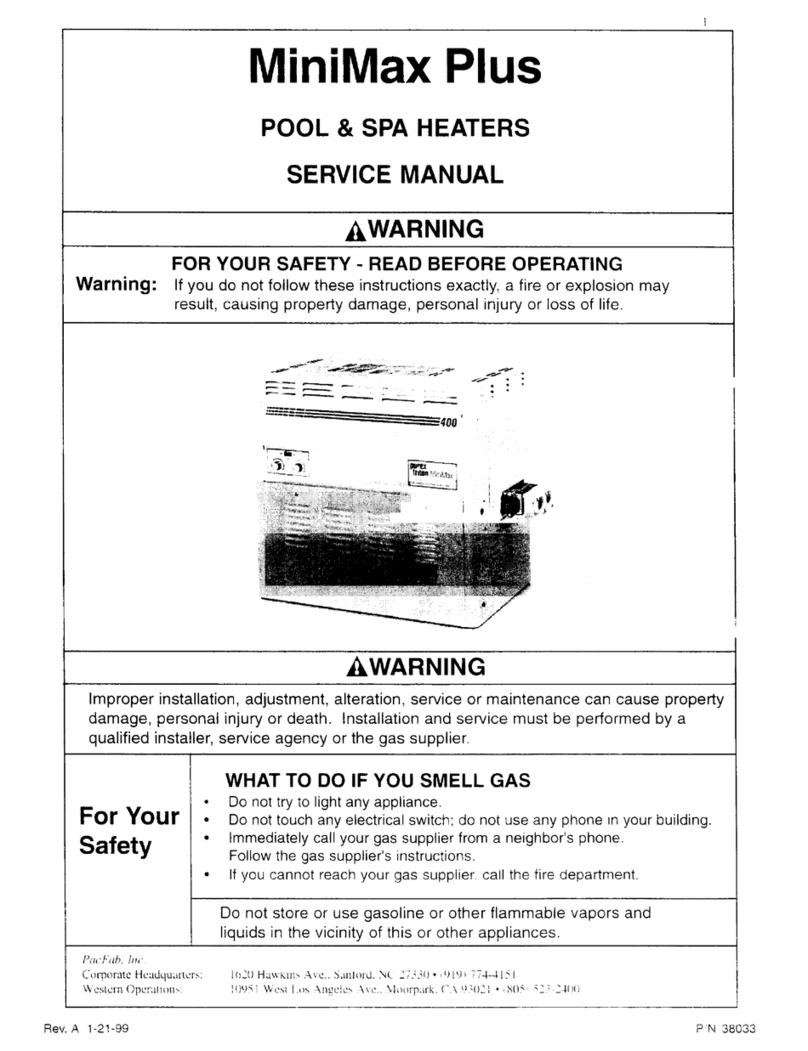
Pentair
Pentair MiniMax Plus, PowerMax MiniMax Service manual

Magen eco-Energy
Magen eco-Energy UMA Solar Sunstar Solar Pool Heating Homeowner's manual
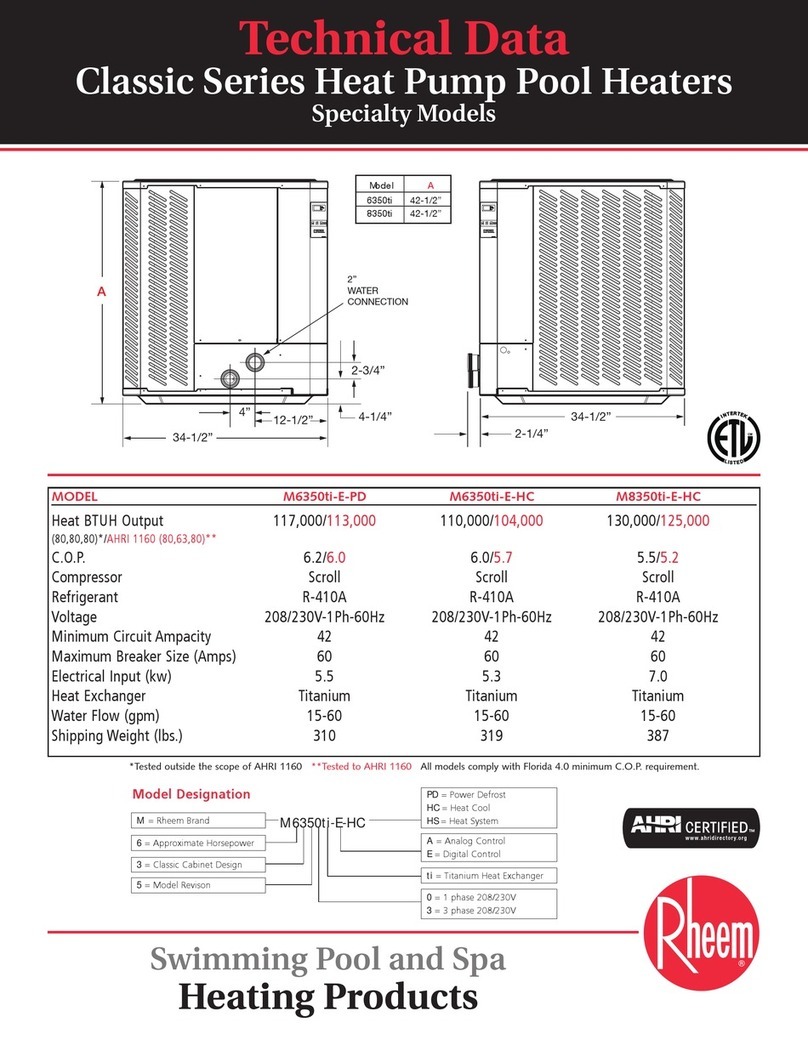
Rheem
Rheem M6350tiHC Technical data
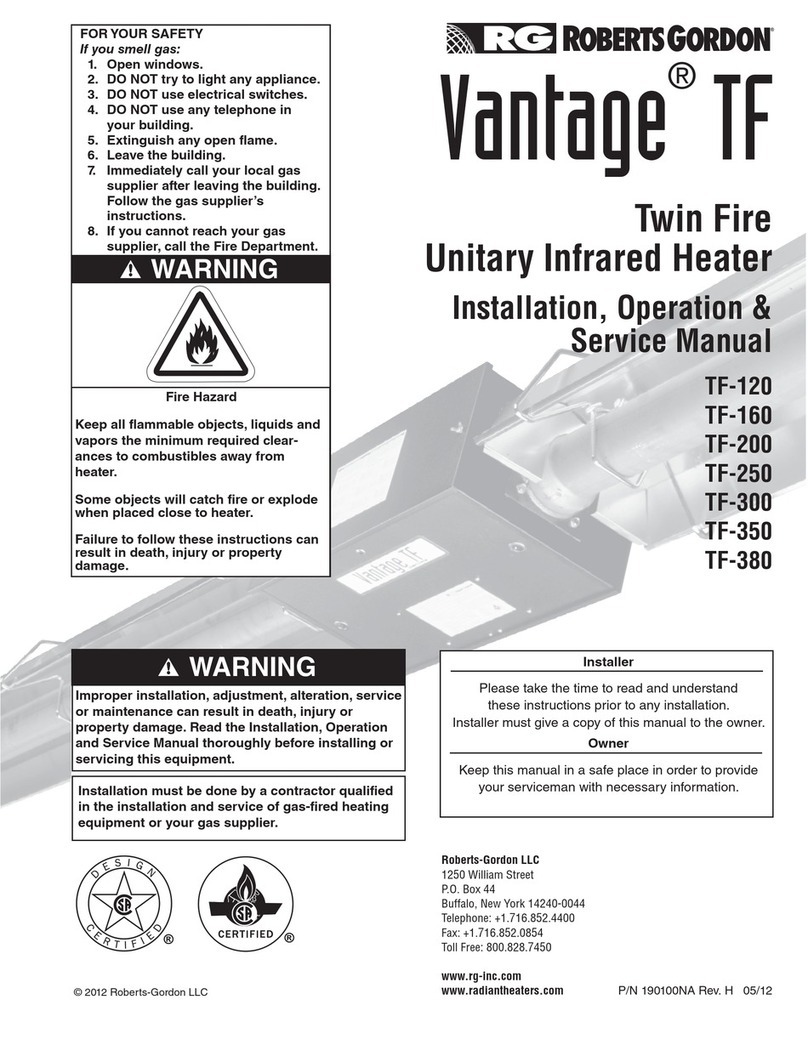
Roberts Gorden
Roberts Gorden Vantage TF-120 Service manual
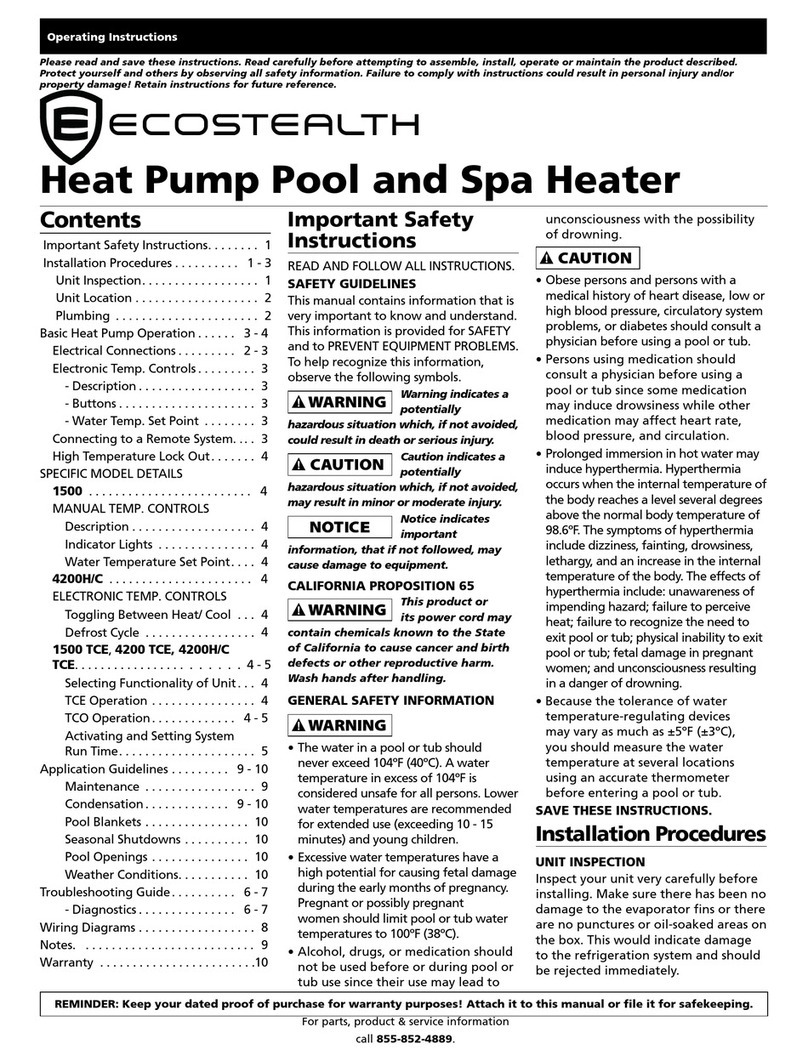
Ecostealth
Ecostealth Heat Pump Pool and Spa Heater operating instructions

Thermo-Dynamics Boiler
Thermo-Dynamics Boiler THERMOTRON OTF Operation, maintenance, and installation instructions
